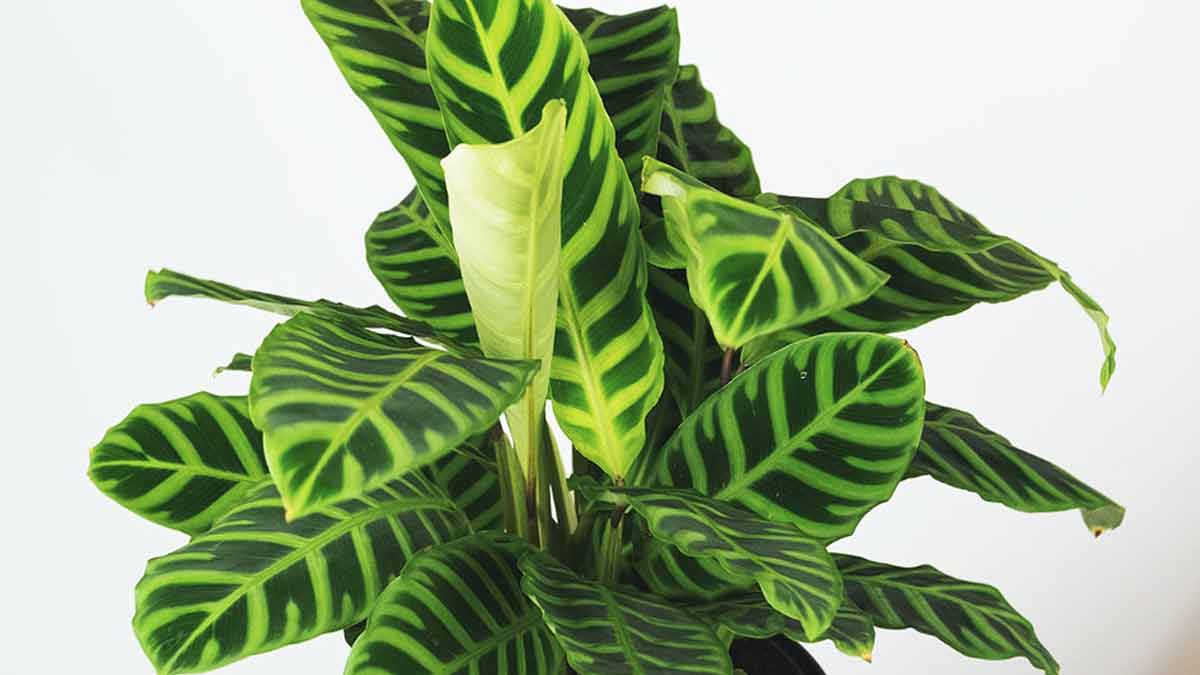Key Takeaways
- Pruning is an essential part of zebra plant care and maintenance that promotes healthy growth by redirecting nutrients and energy toward new shoots.
- Proper pruning techniques include using sharp and clean pruning shears, disinfectant, gloves, a soft brush, or a damp cloth for removing debris from foliage, cutting at a 45-degree angle just above a leaf node, and avoiding over-pruning.
- Post-pruning care includes watering and fertilization to promote new growth without overwatering the soil and monitoring for potential issues such as pests or disease. Other important care tips are maintaining humidity levels, providing adequate lighting, and avoiding overwatering.
Are you struggling to keep your zebra plant well-groomed and healthy? Look no further!
This comprehensive guide will teach you everything you need to know about correctly pruning a zebra plant.
From understanding the basics of this unique houseplant to implementing proper techniques, we’ve got all the essential tips and tricks for maintaining stunning foliage in your indoor garden.
Understanding Zebra Plants And Pruning Basics
Indoor plant enthusiasts often choose zebra plants for their stunning foliage.
Properly pruning these plants is crucial to ensure their growth and health.
Description And Characteristics Of Zebra Plants
Zebra Plants, scientifically known as Aphelandra Squarrosa, are prized for their striking appearance and unique foliage.
Native to the rainforests of South America, these tropical plants feature dark green leaves with bold white veins running through them.
Adapting well to life indoors, Zebra Plants can grow up to two feet tall when correctly cared for.
In outdoor settings with ideal conditions, they have been known to reach up to six feet in height.
To properly care for a Zebra Plant, it’s important to consider several factors.
This includes providing bright indirect light, avoiding direct sunlight, and monitoring humidity levels.
High humidity is necessary for growth and prevents issues like brown leaf tips from occurring on your beloved houseplant.
Why Pruning Is Important For Zebra Plants
Pruning is a vital aspect of zebra plant care and maintenance, as it greatly benefits their overall health and appearance.
By removing dead or damaged leaves and stems, you not only improve the aesthetic appeal of your zebra plant but also allow for better air circulation around the foliage, reducing the risk of diseases like botrytis blight.
For instance, consider a leggy zebra plant that has grown out of control with sparse leaves near its base – this is often due to insufficient light exposure.
Regular pruning in this scenario stimulates fuller growth closer to the base by forcing lower buds to sprout new shoots.
Consequently, your zebra plant will have a more compact and bushy appearance while exhibiting stunning bright green stripes indicative of healthy foliage.
Tools Required For Zebra Plant Pruning
Properly pruning your zebra plant requires the right set of tools, ensuring precise cutting and minimizing the risk of infection or damage.
Here is a list of essential tools for zebra plant pruning:
- Sharp and clean pruning shears: This help make precise cuts without damaging plant tissue.
- Disinfectant (such as rubbing alcohol): Use this to clean your pruning tools before and after use to prevent the spread of disease.
- Gloves: Protective gloves will protect your hands from injury while handling sharp tools and can also help prevent the spread of potential pathogens on your hands.
- A soft brush or damp cloth: Use these to remove debris from the foliage after pruning gently.
When And Why To Prune Your Zebra Plant
Knowing when to prune your zebra plant is important, and you can do this by observing for signs of overgrowth or damage.
Pruning can also aid in channeling nutrients and energy into new growth.
Identifying Overgrowth Or Damage
It is important to regularly inspect your zebra plant for any signs of overgrowth or damage.
Overgrown plants may have leggy stems and thin foliage, while damaged plants may have yellowing leaves, brown spots, or wilted branches.
If you notice any areas that appear unhealthy, it is best to prune them as soon as possible to prevent further damage or infestation.
Use sharp garden shears to trim the affected area just below a node on the stem.
Remove dead leaves or debris around the plant base to maintain optimal growing conditions.
Ideal Timing For Pruning
To keep your zebra plant healthy and looking its best, it is important to prune it at the right time.
Pruning should be done during the growing season when the plant is actively producing new growth.
It’s important to avoid pruning during the winter months when zebra plants are dormant, as this can cause damage or slow down their growth.
Also, don’t over-prune, as this can lead to a lack of foliage and unhealthy stems.
Always use clean pruning shears to prevent the spread of disease and make cuts at a 45-degree angle just above a leaf node for optimal healing.
Step-by-Step Guide To Pruning Your Zebra Plant
If you want to prune your zebra plant, prepare it for pruning first and look for any dead or diseased parts.
Then, you can use stem cuttings or air layering methods to eliminate extra growth and encourage fuller foliage.
Preparing Your Zebra Plant For Pruning
Before pruning your zebra plant, there are a few things you should do to prepare it.
First, make sure that your pruning shears are clean and sharp. Dirty or dull tools can damage the plant and introduce disease.
Next, inspect the entire plant for any signs of pests or disease.
Once your zebra plant is ready for pruning, water it thoroughly a day or two before starting so that it is well-hydrated.
This will help reduce shock to the plant during pruning.
Additionally, consider removing any dead leaves or stems before starting to give you a clearer view of what needs to be pruned next.
Techniques For Pruning
To properly prune a zebra plant, it’s important to use clean pruning shears or scissors.
Begin by identifying which stems must be pruned back and cut at a 45-degree angle just above a node (where leaves attach to the stem).
It’s also important not to remove more than one-third of the plant at once, as this can shock and stress the plant.
If you have an especially leggy zebra plant, consider cutting back more selectively over time rather than all at once.
Additionally, if you notice any dead or diseased portions of your zebra plant, remove those before beginning regular pruning techniques.
Removing Dead Or Diseased Plant Material
Removing dead or diseased plant material is crucial when pruning your zebra plant.
This improves the plant’s aesthetic, encourages new growth, and helps prevent further infection.
Take a careful look at the leaves and stems of your zebra plant, noticing any brown or yellow patches, wilting, or signs of pests.
Make a 45-degree angle cut above the affected area using clean, sharp shears.
Removing dead or diseased material is essential in keeping your zebra plant healthy.
Doing this regularly can help prolong its lifespan and promote fuller foliage growth for a more beautiful display in your home.
Post-Pruning Care For Your Zebra Plant
Once you have pruned your zebra plant, it is crucial to water and fertilize it correctly to encourage new growth.
Always be vigilant for signs of stress or problems like pests or disease, and modify your care routine accordingly.
Watering And Fertilization After Pruning
Proper watering and fertilization are key components of post-pruning care for your zebra plant.
When watering after pruning, it is important not to overwater the soil, which can lead to root rot and other issues.
Fertilizing your zebra plant will help promote new growth and ensure that it remains healthy.
During the growing season in spring and summer, use a water-soluble fertilizer formulated for flowers and foliage every other week.
However, be cautious not to use excessive fertilizer as this may harm your plant rather than help it thrive.
Monitoring For New Growth And Potential Issues
After pruning your zebra plant, monitoring for new growth and potential issues is essential.
You should watch for signs of stress or disease, such as brown leaf tips or leaf spots.
In addition to monitoring the health of your zebra plant, watch for new growth emerging from where you pruned.
This is a good sign that your pruning techniques successfully promoted healthy growth.
Regular fertilization during the growing season can also help promote fuller growth habits and healthier foliage.
Other Important Care Tips For Zebra Plants
As a zebra plant owner, there are other essential care tips that you need to know to keep your plant healthy.
Here are some tips:
- Maintain Humidity: Zebra plants thrive in humid environments. Place a humidifier near the plant or use a pebble tray filled with water to help increase humidity levels.
- Avoid Overwatering: Overwatering can cause root rot, which is fatal to zebra plants. Ensure the top inch of soil is dry before watering, and avoid letting water sit in the saucer.
- Provide Adequate Lighting: Zebra plants require bright but indirect sunlight to grow optimally. They should be placed near an east-facing window or a few feet away from a south-facing window.
- Fertilize Sparingly: While fertilizing is necessary, excess fertilizer can damage the roots and leaves of the plant. Use a water-soluble fertilizer monthly during the growing season but reduce the amount by half during winter months.
- Prune Regularly: Pruning helps maintain the shape and size of your zebra plants while promoting new growth. Always ensure that pruning shears are sharp and disinfected before use.
Common Zebra Plant Pruning Mistakes And How To Avoid Them
Pruning your zebra plant can be daunting, especially if you’re new to plant care.
Here are some common mistakes to avoid:
- Cutting too much: Removing the necessary stems and leaves is important when pruning your zebra plant. Cutting off too much can cause stress and damage to the plant.
- Cutting too little: On the other hand, not cutting enough can result in an unbalanced appearance and hinder new growth. Make sure to trim back enough to encourage bushier growth.
- Cutting at the wrong time: Zebra plants should be pruned during their growing season, typically in early spring or summer. Pruning outside of this time frame can cause harm to the plant.
- Using dull or dirty tools: Always use sharp and sterilized pruning shears when working on your zebra plant. Dirty or dull tools can lead to infection and disease.
- Not monitoring for new growth: Watch for new growth in your zebra plant after pruning. If no new shoots appear within a few weeks, your pruning approach may need adjusting.
- Over-fertilizing after pruning: While fertilizer is essential for healthy plants, adding too much after pruning can overwhelm the newly trimmed foliage. Use a water-soluble fertilizer sparingly and according to instructions for best results.
Avoiding these common mistakes ensures your zebra plant stays healthy and vibrant for years!
Final Thoughts
Pruning a zebra plant can be intimidating for novice gardeners, but it can be done correctly with the right tools and techniques.
Remember to identify overgrowth or damage before pruning, and always wear gloves to protect yourself from sap contact.
Pruning spent flowers, and leggy stems will redirect nutrients towards new growth and promote a fuller growth habit.
Always monitor your zebra plant after pruning for signs of recovery or potential issues such as leaf spots or root rot.







